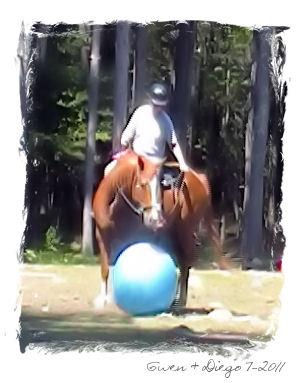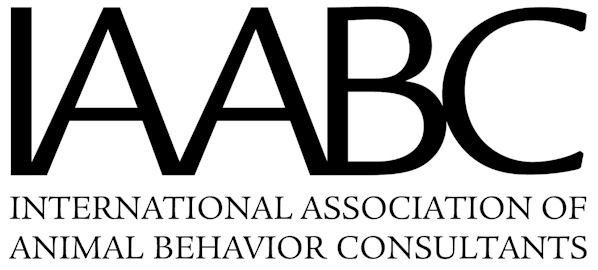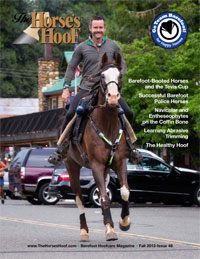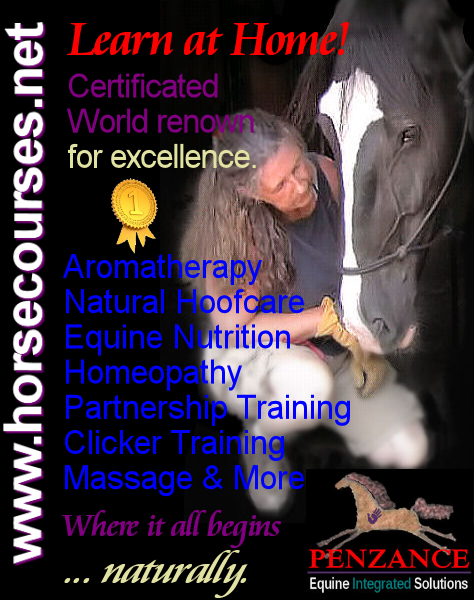 No one is saying that using pressure and release of pressure does not work. No one is saying punishment doesn’t “work”. But there is a difference in the quality of the learning, the speed of the learning, the desire to do the job and the personal decisions that go along with it.
No one is saying that using pressure and release of pressure does not work. No one is saying punishment doesn’t “work”. But there is a difference in the quality of the learning, the speed of the learning, the desire to do the job and the personal decisions that go along with it.
I used to train very traditionally, what most people see as the “normal” way. I did well. I enjoyed what I did. Then I encountered an animal that forced me to think outside the box and try this “silly clicker thing” I had made such fun of because nothing else in my tool box was getting the job done. And in three minutes I completely changed my outlook on pretty much everything in my life. It sounds silly, but it really was life changning.
I tell you, if you have not yet encountered the animal that makes you re-evaluate everything you do, all I can say is that it is truly the most amazing gift an animal can give.
Pressure and release of pressure works very well, and I think for pure safety purposes it is a very impportant skill to teach an animal for the very reason that Bill stated, they have a natural “opposition reflex”. However, as a main training tool, I feel it is lacking, as it relies on creating a disomfort/displeasure that the animal learns to shut off by”complying”. For one, it puts me in a position of being the negative thing, for two it adds an automatic element of resistance to training.
Some see the horse as a willing partner who is happily doing his job when he is complying, however there is a huge difference between real enjoyment and simple relief.
As a last note on partners, I find it both amusing and sad how horse people throw the term “partner” around as it applies to their situation, but then toss it right out the window when it suits them. With clicker training, the horse is very much a true trraining partner.
Post Number: 2281
Registered: 07-2008
Posted on Wednesday, June 06, 2012 – 04:28 pm:
You know from past posts that I agree with Temple Grandin. Trying to figure out fear based behavior and behavior out of attitude can be tricky, especially if you’re using the 3 sec. rule. Do I shoot or not shoot (sorry military).
At some point in time your going to have to make your horse uncomfortable by irritating the horse. Just getting on the horse when it’s happy being with it’s pasture mates is probably irritating the horse. Putting a halter on is irritating a horse. Just domesticating a horse must irritate them.
I guess I just don’t understand the positive and negative reinforcing. To me, the way you described it, it’s the same, depends on how you look at it.
“When one ‘shapes’ behavior, one waits for the horse to move in a certain manner, marks that movement then gives a reward. That’s “positive reinforcement” If that means, if I sit there and wait for my horses head to go down an inch, I click and treat. OK, I’ll buy that. I can do the same thing by applying pressure with my hand and when the horse drops his head an inch I release the pressure but that’s negative reinforcement. I guess it depends on how much time you have to get the same results.
Call pressure and release anything you want but I know it works and it has worked for thousands of years. It sounds like were talking about drug addicts here with the dopamine thing rather than horse training. “The anticipation of a primary reinforcer (food, sex, water) will cause a very sharp rise in the dopamine levels which cause the horse to want to get that ‘feeling’ again.” So doesn’t the relief of pain and that’s where the release of pressure comes in. To me, it’s the same, it feels good to be relieved of the pressure because of the dopamine release.
Username: caballus
Post Number: 1488
Registered: 01-2004
Posted on Wednesday, June 06, 2012 – 04:46 pm:
You got the concept, Bill. And the dopamine stuff is for those scientific minded people who have to have every statement ‘proven’ scientifically or they don’t get it. *GRIN* … but look at it this way, too — by shaping with +R, one waits, marks, treats and the horse then repeats the behavior because the horse CHOOSES to do so. He WANTS to earn that reward. The horse that is responding to pressure on the poll is lowering his head out of avoidance … a form of force. Now, again, I’m not a purist – I use both +R and -R. There *IS* a marked difference in the horses’ demeanors between the two forms of teaching. When a horse trots up to me and starts ‘offering’ all these behaviors to earn a treat, I find that great! He’s tuned in and willing to learn! The horses that are responding to -R aren’t always so willing but they do it anyway. So, there is a difference – and yes, traditional ‘horse training’ was and is ‘effective’ as avoidance to conditioned behaviors … I’ve just found over the years that +R is, as mm says, it helps cement that ‘partnership’ that is an honest and true one.
Post Number: 2350
Registered: 10-2007
Posted on Wednesday, June 06, 2012 – 06:51 pm:
Then Bob, I guess the way you see it is that it comes down to the ultimate question, do you want to get behavior by being a source of good things to your horse or something he wants to shut off?
The feelings of joy and relief are very, very different. If I eat because I am famished, yes, I am relieved, but I don’t truly enjoy the food because I am too busy trying to gain relief. If I eat because I chose a meal, made it, and enjoy it with good company, that is a very different feeling. If I move towards someone because they are pointing a gun at me and moving closer gets them to stop waving it around or pointing it at me, that is relief. If I move towards someone because I genuinely like them, agin, same behavior, different reasons.
Doing something one way because it has always been done and has always worked well enough is not the answer for me, stoning, drowning or burning “witches” was the preferred method for things for a very long time too! Bleeding sick people was a very accepted way of treating medical conditions. It does not mean that the method does not need to or have room to evolve.
And I assure yu, shaping a head lowering takes little to no time at all and becomes an offered behavior very quickly. My mare learned in under a few minutes and still regularly offers it to this day from a single shaping session and pretty much never really worked on since! Animals trained with positive methods have been shown to retain the lessons better, be able to come back after a long time away from the job with little to no difficulty remembering and do offer tge behavior much more readily than horses trained with compulsion.
Post Number: 2064
Registered: N/A
Posted on Wednesday, June 06, 2012 – 07:14 pm:
thats all well and good but what do you guys do for BAD behavior??
like running a person over; threatening to kick; pinning ears and charging??
no time for click/treat in that kind of situation; that takes QUICK and ASSERTIVE measures to get the point across that it is unacceptable and WILL NOT BE TOLERATED EVER!
and another scenario…
i have a herd of 5, all turned out together.
when i go into the paddock, i DO NOT allow ANY herd behavior AT ALL. it is respect for ME and it keeps me safe. if one pins ears, makes ugly faces, whatever , at another, they get punished right THEN; i make the punishment fit the crime.
i have no time/tolerance for click/treat; they get either smacked, kicked, run off, chased, pushed around, whatever punishment i feel fits the moment. then they had better ask nicely to rejoin the herd or they are out again.
so, what would you do in that kind of situation??
You don’t get what you WISH for, but you get what you WORK for…
Username: caballus
Post Number: 1489
Registered: 01-2004
Posted on Wednesday, June 06, 2012 – 08:54 pm:
8hoofs — I teach that I’m the Leader from the get go before even starting anything. I say “hello” first and then with a very pushy horse will go right into very assertive hind-end disengagements. Both directions. A couple of those and the head drops, the eyes soften and the lick and chew ensues. That’s not part of CT but its how I work to get their attention and how I get the horse to look out for me so I don’t always have to be lookin’ out for the horse.
I was told the horse at the CHA Regional Conference that I worked with needed a chain over his nose to lead him – he was pushy and rude and frequently dragged his handler around. A couple of HEDs (not even full come arounds) and he was respectfully following me at the end of the lead, stopping when I stopped, walking when I did and keeping his eye on me, lookin’ out for *me*. He did nip me at one point so I more or less ignored that other than to back him up and do another short HED. Absolutely not ONE issue after that. Not one. He was the most mannerly, light, respectful ‘young man’ — (only 6 years old) and was a great guy to work with. He tried hard. I understand he was not quite as ‘mannerly’ the next day or so when another trainer worked with him. But rather than being ‘assertive’ with light corrections, the trainer was heavier handed, used a whip and his responses were reactions based in fear. He did what he was asked to do eventually — but you could see his tail tucked, his hind end braced as he lifted his head/front end to get away and then pushing himself off the front end to scramble away from the trainer backwards. He was reacting with aversion behavior. He was not *choosing* to stand or be respectful or ‘learn’ the lesson as he did when I was working with him with CT and actively ‘participated’ in doing what I was asking. HUGE difference between the two ‘methods’ of training. I don’t see horses as “animals” to be forced into submission. I view horses as ‘friends’, just as my tagline states. Each one with his or her own personality and needs. (cont.)
That being said – Horses are horses and will be horses. Period. Its up to the human to establish the “leadership” — in the feral herds, Leaders are ‘chosen’ by the others; the Lead Mare does not take the role by force and intimidation or aggressiveness. But she doesn’t put up with any malarchy, either. OTOH, the “Alpha Mare” will use intimidation, force and punishment and therefore the others stay away from her. They don’t WANT to hang out w/her and she has no real use for them. She’s doing a job – period. Not creating families or sub-group ‘friends’.
What happens with CT is the horse will seek to earn that treat. He learns quickly that unwanted behaviors earn him n.o.t.h.i.n.g. … and quickly that unwanted behavior becomes extinct. No fanfare, no punishment, no correction (unless the horse is a very aggressive horse but that’s a situation out of the ‘norm’.) — the ‘right answers’ are rewarded and the horse will works hard to think it all through to figure out how to earn another reward. Again, the unwanted, ignored behavior becomes extinct as a matter of course.
I will add a PS to this — with a very aggressive horse (and I’m talking about one that attacks without warning) I would work to initiate him/her to the CT with the horse INSIDE the stall and me OUTSIDE the stall (or paddock, whichever) … and not even think to try to do HED with that horse. A very IMPORTANT aspect to this is congruency AND that everyone who handles said horse is consistent in attitude and manner — otherwise, get ONE person to work with a horse like this, work through the aggression, rehab the PTSD and then teach the others needed how to work with the horse safely. Too many cooks spoil the broth and just make things worse.
Post Number: 2351
Registered: 10-2007
Posted on Thursday, June 07, 2012 – 07:39 am:
8Hoofs, to further elaborate on what Cab is saying, in the moment a dangerous behavior is addressed on the spot. That is not what I consider a training session, it is damage control. BUT anytime I need to go to that length .ineed to assess what happened? What wentwrong? Where was the hole in my real training?
The point I am trying to make is that there is a ton of training that should be going into a horse, it should not all be about damage control or else there is a serious flaw in the training, handling and management of that situation and the handler isin more danger than they know.
But I would certainly never whip out my clicker when a horse is actively doing something dangerous or even in a herd unless there had been tons of previous training. That is an advanced level of training, not entry level.
Post Number: 2066
Registered: N/A
Posted on Thursday, June 07, 2012 – 08:26 am:
there is a HUGE difference , then, in training; and, as i see it; all horses, a some point in their dealings with humans, need the “damage control” training, and by that i mean more than moving hind quarters.
i can see a use for clicker training, if that is the method you choose, BUT, and it is a huge capital BUT, a horse HAS to have the basic respect and manners and DISCIPLINE FIRST, then the clicker training could be used for certain things.
but to say that C/T can solve all with nicey-nice-heres-a treat-honey , that, to me, is not safe .
i do not beat my horses by ANY stretch BUT, if they disrespect ME, then they get DISCIPLINE; REAL discipline, not just back up a step, move over a step. they get corrected so IT MEANS SOMETHING.
just like with kids; i got spankings when i was a kid, i got the dog leash across my butt, i got a hairbrush, i got smacked across the mouth if i mouthed off to my parents…i turned out GREAT! my son got the same, and he is a wonderful, well rounded man.
there is a line in the sand between abuse and discipline….and a whole lot of horses out there need DISCIPLINE to be good solid citizens; then, if you choose, clicker train for fine tuning. but to say that those of us who choose to really discipline our horses to keep US safe and to make them into solid citizens are using FORCE and making them submit or abusing them or beating them, is not fair.
and there are a whole lot of kids that need a good DISCIPLINE, too!
You don’t get what you WISH for, but you get what you WORK for…
Username: caballus
Post Number: 1494
Registered: 01-2004
Posted on Thursday, June 07, 2012 – 11:56 am:
Actually, CT can and is used very effectively in teaching the basic manners. Even with, and actually more so, with PTSD horses and very, very rank horses. I know its a paradigm but again, when the ‘right’ behavior is rewarded, the horse will strive to repeat that behavior and quickly, the ‘wrong’ behavior becomes extinct — extinguished — it no longer exists. It’s gone. And just like kids — if they’re acting out and receive attention for acting out, they’re going to continue to do that because they get the attention for it. But if they receive attention for GOOD behavior then they’ll keep on striving to get that attention with good behavior. Kids also can analyze and comprehend a spanking. Horses don’t do that — they’re not going to sit around thinking, well I did this or that so I deserved the kick in the belly or the whip butt across my face. They’re only going to react and that reaction is based on fear so … again, they’ll do what is asked or avoid something as an “avoidance” behavior based on fear – and to avoid pain and discomfort. That undermines the trust factor … the horse trusts the human to never cause him pain and to be fair or to cause pain if he does such and such; the kid comes to understand and trust the *concept* of the punishment. Humans and horses just don’t think the same way. Horses and dogs don’t think the same. Humans, dogs are predators; horses are animals of prey. Different thought patterns.
I disagree with you on the point that you say, “Those of us who choose to really discipline our horses … are using FORCE … is unfair.” When one strikes a horse with a crop, that’s force. When one slugs a horse in the face, that’s force. When one kicks a horse in the belly (as been said to be just like the mare does.) .. that’s force. That’s aggressive. It’s bullying. And that IS causing the horse to ‘submit’. Just as much as if your husband were to threaten you to wash the dishes or vaccum the house or have sex. That’s force. If a horse kicks out at a human, in his mind, he has GOOD reason to do so! What is the human doing to cause that behavior? They just don’t expend their energy like that “just cause they can” … if a horse kicks out, strikes out, rears up, bucks, there have been plenty of warnings prior … and perhaps the human is just not listening. Sometimes, with very sensitive horses or very traumatized horses, the mere presence of a human within ‘his space’ is enough to cause this extreme behavior. So the human needs to get out of the horse’s space for a time being and let the horse settle. Choose another ‘task’, another lesson, another approach. “Going after’ a horse in that mind set only cause MORE aggressiveness and more fear which shuts the mind down even tighter than it already is. Most horses are not at that extreme. If one were to approach a wild horse (unhandled Mustang) with a crop, ropes, etc. as the horse is aggressing, then one could expect to very possibly die. Period. Survival of the fittest and we don’t hold a candle to the horse in that department.
One more comment … *grin* … moving the feet in any direction, to a HORSE, puts the human in lead position and to the horse, that means MORE than any ‘physical control/correction/discipline/punishment’ we can administer to him. There’s all sorts of other ‘stuff’ (consequences in thinking & behavior) that comes with the horse’s view of Leader. It’s just the way they’re hard-wired. They just ain’t wired like we are.
Post Number: 2282
Registered: 07-2008
Posted on Thursday, June 07, 2012 – 11:59 am:
Caballus, I would have to respectfully disagree, with the exception of the hind quarter disengagement.
I would say that the horse you worked with was already fairly well trained before the present owner got him. He’s a tester. The present owner allowed him to get that way. He tested you, you corrected him and he responded in a positive manor, his previous training (before the present owner) kicked in. Of course my thoughts are from the outside looking in.
The same with the second trainer..new face..new test. This time the corrections were probably made differently but probably with a lasting effect. That training by either of you may go down the tubes. The horse will test the present owner agian and hopefully the more aggressive approach will be embedded in his brain for awhile. The owner needs the training, not the horse.
“in the feral herds, Leaders are ‘chosen’ by the others; the Lead Mare does not take the role by force and intimidation or aggressiveness.” I would have to disagree somewhat with that. Possibly in a feral herd some of this may be true but most of use are dealing with domesticated horses, the ones that humans have screwed up, apples and oranges. From what I’ve seen (not wild but a large herd) Everything “is” about intimidation and aggressiveness. The herd hierarchy is established this way, with few exceptions. Even within an established herd, there is still intimidation and aggressiveness, sometimes brutal. A tap with a whip pales in comparison. Usually insecure, middle of the pecking order horses. Some horses, even geldings, will assume the roll without a challenge. Horses will always be looking for weakness among the leaders. If the leader shows weakness, the leader will get challenged. If your herd leader is being challenged, look for a reason why. Never show weakness. You/ human/ leader, should act the way a horse would act and if that means less than gentle, so be it. That’s how they get respect. There is always an exception but not easily understood.
Post Number: 1497
Registered: 01-2004
Posted on Thursday, June 07, 2012 – 12:15 pm:
Yes, B — I’m sure. And since the handler of that horse was taught to use the whip, etc. and that will have a lasting effect BUT … and here’s the key to it … the horse will ‘perform’ but as ‘aversion’ behavior — so will continue to ‘test’ (and you’re absolutely correct — he tested me – once.) He will continue to test UNTIL he is taught so he can respond ‘willingly’ rather than react with aversive behavior. In other words, just as studies have shown, when using punishment to teach a horse one will ALWAYS have to use ‘punishment’ to get what one wants. On the contrary, when using positive reinforcement, the horse WANTS to do what is asked because he now understand that there is something pleasurable to follow the behavior. I am again going to use this analogy albeit extreme — rape is not pleasant — its aggressive and its all about ‘control’ by the offender. Sure, the person being raped will ‘submit’ to keep from gettin’ hurt worse or killed but does that mean one wants to be raped every relation? NO! … Its a natural instinct to protect onesself and more so for a horse. But when faced with a loved one then the idea of having relations is much more pleasant and is even initiated. Yes, I said it was an extreme example but it equates to punishment/force/control vs. willingness/desire to please/enjoyment.
As for herd behavior? The ones who do the most physical fighting are the ones who are most insecure about their place in the herd. The lowest ranking horses are the most active fighters. In order for a horse to feel ‘safe’ in life he HAS to be either leader or follower. So they vy for the position. Stronger ones, in spirit, assume the role of leader with little fanfare. Yes, a simple ‘correction’ here or there and they are assertive enough (NOT aggressive) in their demeanor so the others respect them. You are correct — humans need to act like horses but I would prefer that to be exhibiting strong leadership qualities rather than the underdog behaviors. Assertiveness is the opposite spectrum from aggressiveness. Most think force is assertive when its truly aggressive and shows weakness of the individual. Horses sense that weakness as a matter of survival and hardwiring. Respect out of fear is NOT the same as respect for a trusted leader.











I do not really belong in this conversation because I have little to no knowledge about horses. However, with the help of Marv, Kelly,Bob, and Gwen, I trained my horse from birth. After working with him every day for six months until I took him from his Mother, I was injured at work and could not go into the area with my horse. I became afraid of being close to him because he did not respect my space. So, I used clicker training, (I just say YES for the click), to teach him to touch things, back, etc. By the time I was well, I was prepared to go in with my horse. Now,after 17 years, I ride him only bareback and with a halter and lead…no bit. He obeys mostly verbal commands. When he very rarely acts up a bit, all I have to do is say, “Do you want to go out?”….I had no round pen, so I had to just chase him away from the barn and his safe place…his stall when he was young and acting up. He does NOT want to go out as he prefers to stay close to me when I am in his pasture. He knows a great many verbal commands. When we ride, I just talk to him and get the result I want. If anything like the neighbor’s huge tractor with a new machine show up, I simply say,”Head down”,although he is learning to do that himself…and he calms down.
I know this post probably does not belong here,but I thought I might put it here just in case there were other readers not as advanced as the rest of you, LOL! Clicker training is awesome! Thanks to all who helped me and Carat!
On HERD BEHAVIOR — http://www.equine-behavior.com/Dominance_and_the_horse1.htm